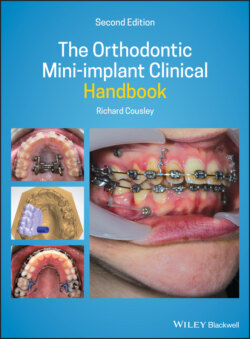Читать книгу The Orthodontic Mini-implant Clinical Handbook - Richard Cousley - Страница 30
1.17 Biomechanical Side‐effects
ОглавлениеIn many respects, conventional fixed appliances often only exhibit subtle biomechanical side‐effects such as frictional binding, tooth tipping and anchorage loss, because these effects are usually localised to single teeth or a group of several teeth. For example, traction applied at the coronal level (to a bracket) may result in tipping and poorly controlled bodily movement of that tooth. Since the adjunctive use of mini‐implants provides more profound anchorage, active in all three dimensions and extrinsic to the fixed appliance, the side‐effects may also be more strongly expressed and affect the entire arch (when continuous arch mechanics are utilised).
Figure 1.8 Labial ulceration caused by this mandibular mini‐implant's insertion at the mucogingival junction and by the active movement of the adjacent labial sulcus.
Figure 1.9 (a) Elastomeric traction auxiliary in contact with the alveolar mucosa following insertion of maxillary buccal mini‐implants. (b) Maxillary alveolar ulcerative gingivitis after one month with the powerchain in situ, along with generalised gingival hyperplasia resulting from poor oral hygiene. (c) Photograph taken a further four months later with new traction applied following an improvement in oral hygiene.
Two pertinent examples of this occur if oblique traction is applied from a mini‐implant directly to a canine bracket for anterior segment retraction, with either a flexible or a rigid archwire in place. In the first instance, this oblique vector of traction encourages the canine to tip distally causing the flexible archwire to exhibit a ‘rollercoaster’ bowing phenomenon (Figure 1.10a). In the latter situation, the oblique traction causes a rigid archwire to rotate the entire arch (around its centre of rotation near the premolar apices), causing a combination of incisor extrusion and retroclination and molar intrusion (Figure 1.10b). This manifests clinically as a molar openbite, with development of a vertical step between the first and second molar teeth (if the second molar is unconnected).
Figure 1.10 Diagrams showing the vertical side‐effects of an oblique vector of traction from a buccal mini‐implant to the anterior teeth on (a) flexible and (b) rigid archwires. Distal tipping of the canine and a rollercoaster bowing of the archwire occur in scenario (a), whilst predominantly molar intrusion occurs in (b).
